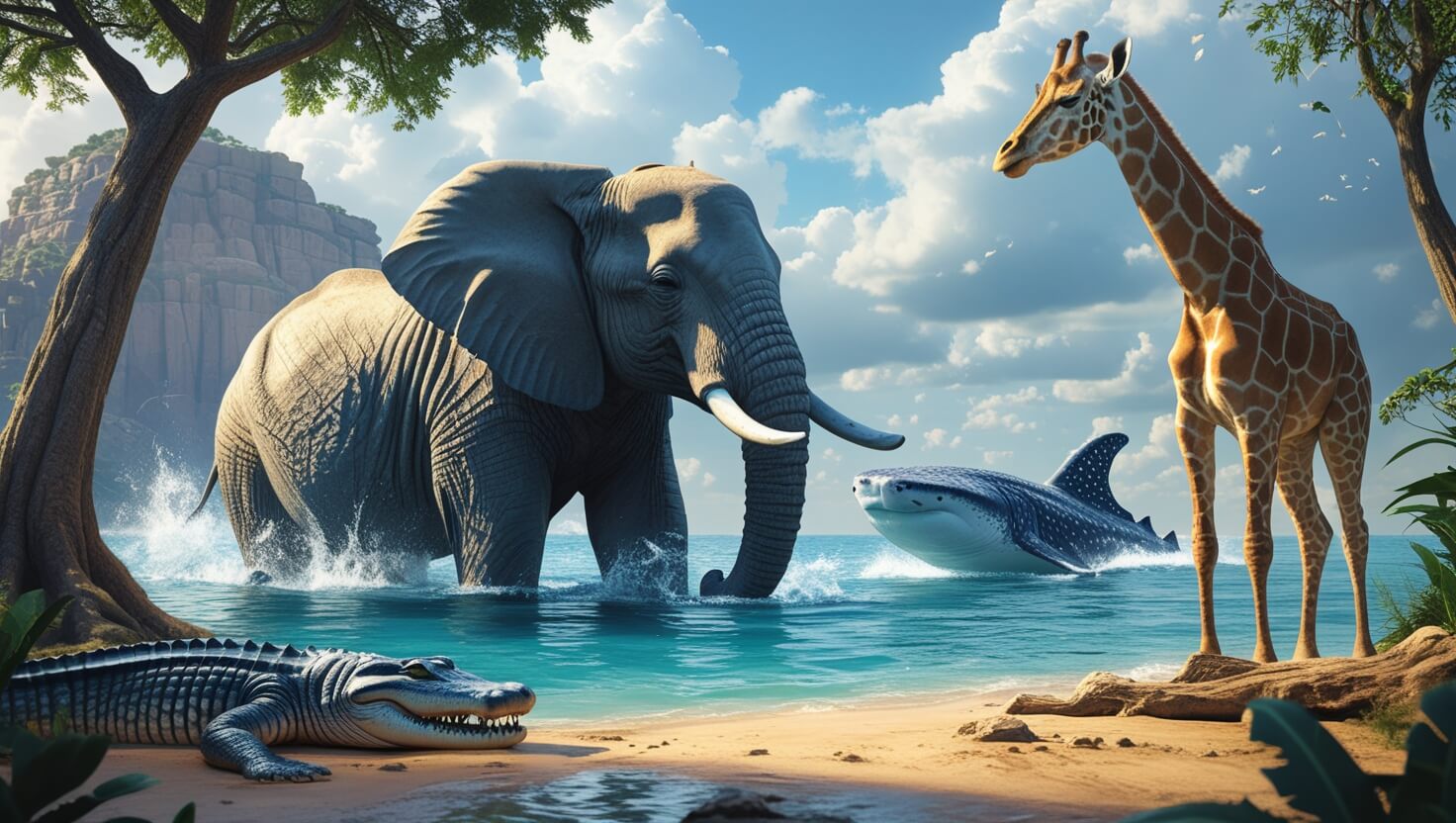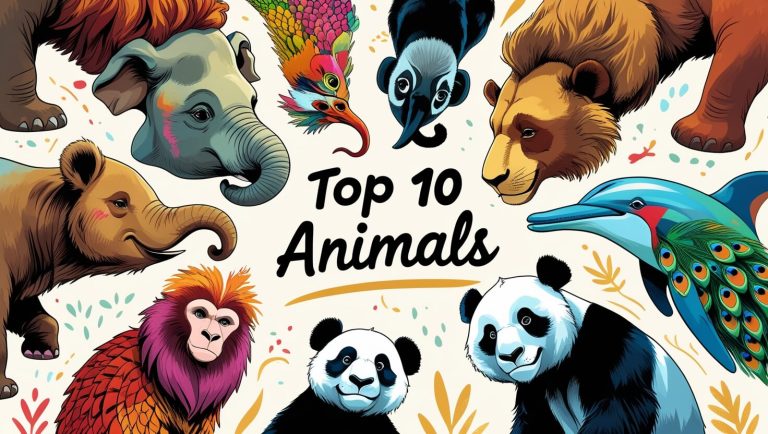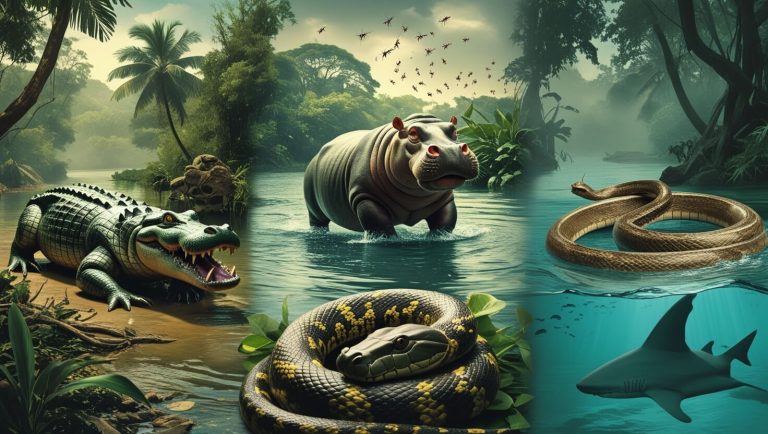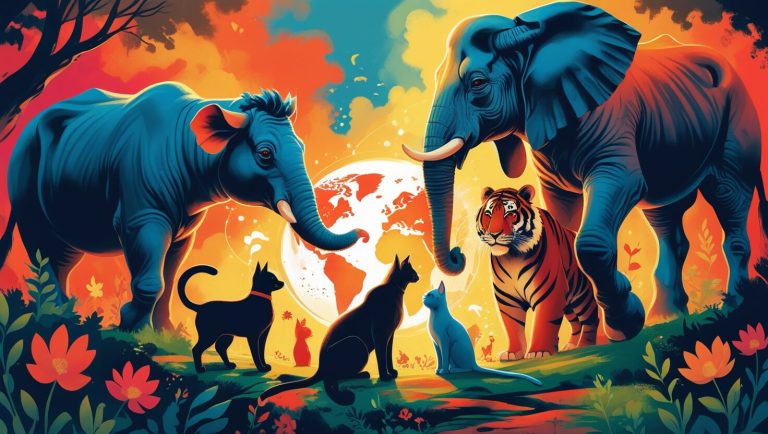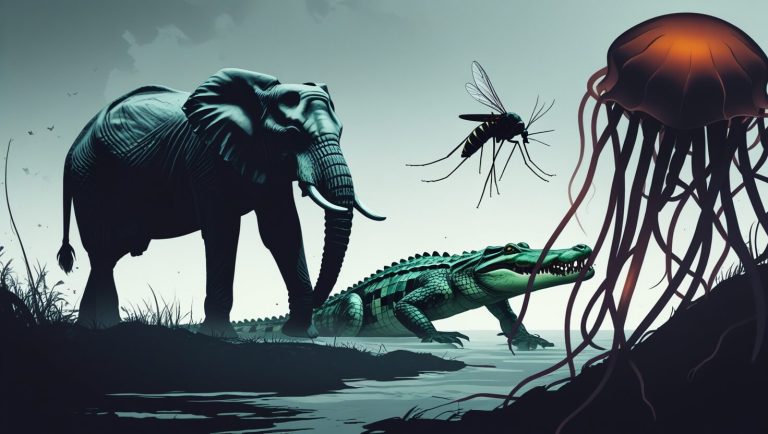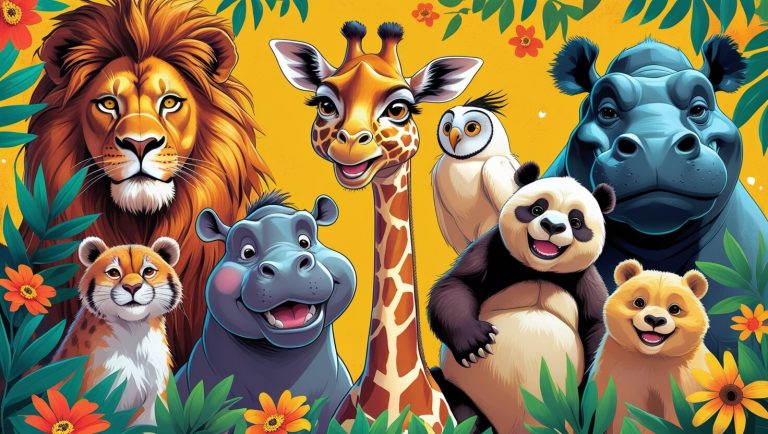Top 10 Biggest Animals in the World (Giants Among Us)
Look around you. The chair you’re sitting on, the car you drive, the building you live in—we humans build big things. But nature has been creating living, breathing giants long before we ever walked the Earth. These incredible animals push the limits of size and weight, making our biggest creations seem small in comparison.
From the depths of the ocean to the vast savannahs, the animal kingdom is home to creatures of unbelievable scale. But what does “biggest” really mean? Is it the tallest, the longest, or the heaviest? In this list, we will explore all three! We will count down the top 10 biggest animals based on their weight, which is the most common way to measure an animal’s overall size. Get ready to be amazed by the true titans of our planet.
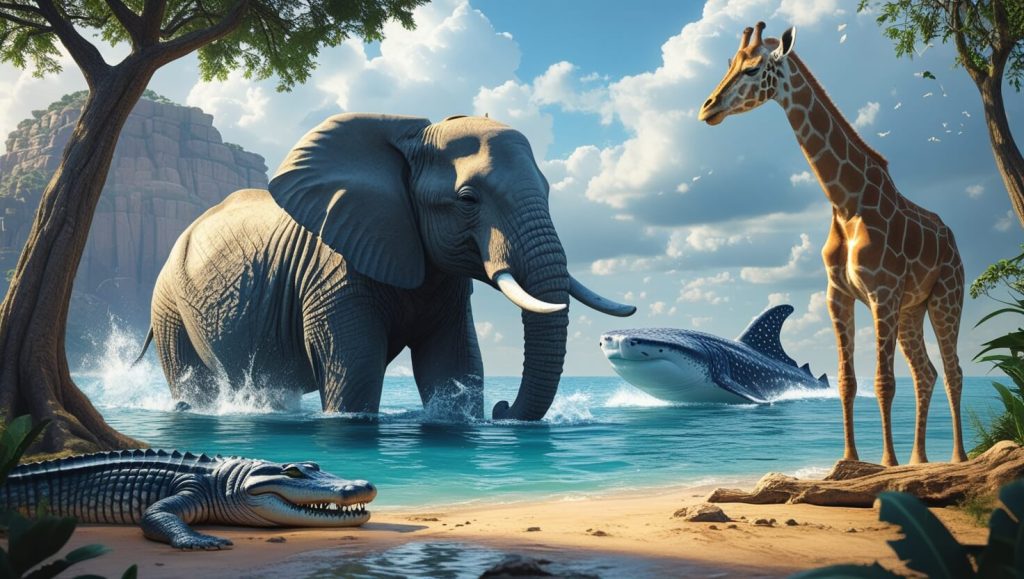
What Makes an Animal “Big”?
Before we start our countdown, let’s think about what “biggest” means. An animal can be the longest (like a snake), the tallest (like a giraffe), or the heaviest (like a whale). For this list, we are focusing mainly on weight, as it gives the best idea of an animal’s total mass and presence. However, we’ll also mention incredible lengths and heights where they are truly astounding.
It’s also important to remember that many of these animals are endangered species. Their immense size doesn’t protect them from threats like habitat loss, climate change, and hunting. Learning about them is the first step toward helping to protect them.Now, let’s meet the giants!
Summary Table: Top 10 Biggest Animals
| Rank | Animal | Type | Approx. Size / Weight |
|---|---|---|---|
| 1 | Blue Whale | Marine mammal | Up to 33 m, 190–250 tonnes |
| 2 | Whale Shark | Fish | Up to 20 m |
| 3 | African Elephant | Land mammal | 3,000–6,000 kg |
| 4 | White Rhinoceros | Land mammal | ~2,300 kg |
| 5 | Giraffe | Land mammal | ~1,930 kg, ~6 m tall |
| 6 | Hippopotamus | Land mammal | ~1,500 kg |
| 7 | Saltwater Crocodile | Reptile | Up to 7 m, ~1,000 kg |
| 8 | Sperm Whale | Marine mammal | Up to 18 m, ~57 tonnes |
| 9 | Colossal Squid | Invertebrate | ~495 kg (females), possibly more |
| 10 | Giant Squid | Invertebrate | Up to 10 m (including tentacles) |
Top 10 Biggest Animals in the World
Of course. Here is a 2500+ word blog post about the top 10 biggest animals in the world, written in easy English and including a Q&A section.
1. The Blue Whale: The Unmatched Giant
When we talk about the biggest animal in the world, there is no debate. The champion, the heavyweight title holder, the true king of size is the magnificent blue whale.
- Average Length: 80-100 feet (about the length of three school buses!)
- Average Weight: 200 tons (or 400,000 pounds! That’s equal to about 33 large elephants).
- Habitat: All of the world’s oceans.
The blue whale isn’t just the biggest animal alive today; scientists believe it is the largest animal ever to have existed on Earth, even bigger than the largest dinosaurs!
Mind-Blowing Blue Whale Facts:
- Their tongue alone can weigh as much as an elephant.
- Their heart is the size of a small car and weighs about 400 pounds. You can hear its heartbeat from over 2 miles away!
- A baby blue whale (a calf) gains about 200 pounds every day for its first year of life. It drinks about 150 gallons of its mother’s milk daily.
- They are surprisingly graceful. Despite their enormous body size, they are sleek swimmers.
- They are also one of the loudest animals. Their low-frequency calls can be heard by other whales hundreds of miles away.
Sadly, these gentle giants were hunted almost to extinction for their blubber and oil. They are now endangered species, with only an estimated 10,000 to 25,000 left in the wild. Protecting them is one of the most important wildlife conservation efforts in the world.
2. The African Bush Elephant: The Largest Land Animal
If the blue whale rules the sea, the African bush elephant is the undisputed king of the land. It is by far the biggest land animal walking the Earth today.
- Average Height: 10-13 feet at the shoulder.
- Average Weight: 6 tons (12,000 pounds) for males. Females are smaller.
- Habitat: Savannas, grasslands, and forests of Africa.
These incredibly intelligent and social creatures are a wonder to behold. Their size is a key part of their survival, protecting them from most predators.
Amazing African Elephant Facts:
- Their trunks have over 40,000 muscles and are used for breathing, smelling, trumpeting, drinking, and grabbing food.
- Their giant tusks are actually long teeth that keep growing throughout their lives.
- They have a highly developed brain and show behaviors like grief, learning, play, and compassion.
- Elephants are a keystone species, meaning they help shape their entire ecosystem. They create water holes by digging in dry riverbeds and clear paths through dense forests that other animals use.
Like blue whales, African elephants are an endangered species, primarily due to illegal poaching for their ivory tusks and habitat loss.
3. The Whale Shark: The Ocean’s Gentle Filter-Feeder
Don’t let the name fool you! The whale shark is not a whale; it is a fish—in fact, it is the largest fish in the world. But like the largest whale species, it is a gentle giant that feeds mostly on tiny plankton.
- Average Length: 40 feet (though the largest confirmed was over 60 feet long).
- Average Weight: 20 tons (40,000 pounds).
- Habitat: Warm waters in tropical oceans around the world.
These beautiful creatures are easily recognized by their wide, flat heads and unique pattern of white spots and stripes on their dark grey backs.
Incredible Whale Shark Facts:
- They are filter feeders. They swim with their huge mouths open, sucking in water and filtering out small fish, plankton, and crustaceans.
- Despite having thousands of tiny teeth, they don’t use them for eating.
- Their skin is up to 6 inches thick, providing excellent protection.
- They are generally docile and often allow swimmers to snorkel alongside them.
4. The Colossal Squid: The Deep-Sea Mystery
While the giant squid is famous for its length, the colossal squid is the true heavyweight of the deep. It is the world’s largest invertebrate (an animal without a backbone) by mass.
- Estimated Length: Up to 46 feet long, including its tentacles.
- Estimated Weight: Possibly up to 1,100 pounds or more, with some estimates being much higher.
- Habitat: The deep, cold waters surrounding Antarctica.
This creature is so elusive that scientists have rarely seen a live one. Most of what we know comes from specimens found in the stomachs of sperm whales (their main predator) or accidentally caught by fishermen.
Chilling Colossal Squid Facts:
- They have the largest eyes of any animal on the planet—each one can be as big as a dinner plate! This helps them see in the pitch-black depths of the ocean.
- Their tentacles are equipped with sharp, swiveling hooks, used to grab and hold onto prey.
- They are a powerful reminder of how much of our ocean, especially the deep sea, remains unexplored.
5. The African White Rhino: The Tank of the Savanna
After the elephant, the African white rhinoceros is the second largest land mammal and the heaviest of all the world’s rhino species.
- Average Height: 5-6 feet at the shoulder.
- Average Weight: 2.5 tons (5,000 pounds) for males.
- Habitat: The grasslands and savannas of Africa.
The name “white” is actually a mistake from the Afrikaans word “wyd,” meaning “wide,” referring to its wide, flat mouth, which is perfect for grazing on grass.
Powerful White Rhino Facts:
- They have two horns on their snout, made of keratin (the same substance as our fingernails). The front horn is much longer.
- Despite their massive size and tough appearance, they can run at speeds of up to 30 miles per hour.
- They have very poor eyesight but an excellent sense of hearing and smell.
- They are critically endangered due to relentless poaching for their horns.
6. The Hippopotamus: The River Horse
The hippopotamus may look like a slow, lazy creature, but it is actually one of the most dangerous and aggressive animals in Africa. It is the third-heaviest land animal after the elephant and white rhino.
- Average Height: About 5 feet tall at the shoulder.
- Average Weight: 3-4 tons (up to 8,000 pounds) for males.
- Habitat: Rivers, lakes, and mangrove swamps in sub-Saharan Africa.
Hippos spend most of their day in the water to keep their massive bodies cool under the hot African sun.
Surprising Hippo Facts:
- They are surprisingly fast and can run up to 19 mph on land for short distances.
- Their name comes from the ancient Greek for “river horse.”
- They secrete a natural red-colored sunscreen that moistens their skin and may protect it from germs.
- Their enormous mouths can open a full 180 degrees, revealing large canine tusks.
7. The Giraffe: The Tallest Animal on Land
When it comes to height, no animal can compete with the giraffe. It is, by a huge margin, the tallest living animal on Earth.
- Average Height: 16-20 feet tall.
- Average Weight: 1.5-2 tons (3,000 pounds) for males.
- Habitat: Savannas and open woodlands of Africa.
A giraffe’s incredible height gives it access to food—like leaves on tall acacia trees—that other animals can’t reach.
Towering Giraffe Facts:
- Their necks are about 6 feet long but contain only seven vertebrae—the same number as a human neck!
- They have a powerful heart, about 2 feet long and weighing 25 pounds, to pump blood all the way up to their brain.
- Their long, dark tongues (about 20 inches long) are prehensile, meaning they can use them to skillfully wrap around and pull leaves from branches.
- A newborn giraffe calf is already about 6 feet tall at birth.
8. The Saltwater Crocodile: The Largest Reptile
The saltwater crocodile is the king of reptiles. It is the world’s largest living crocodilian and the largest reptile on the planet today.
- Average Length: 17 feet for males, but they can grow much larger.
- Average Weight: 1,000 pounds, but large males can exceed 2,000 pounds.
- Habitat: Brackish and freshwater regions in India, Southeast Asia, and Australia.
These ancient predators are perfectly designed for hunting. They are ambush predators, known for their immense power, incredible speed in water, and devastating bite.
Fearsome Saltwater Crocodile Facts:
- They have the strongest bite force of any animal ever measured. It’s more than 10 times stronger than a great white shark’s bite.
- They can live in both saltwater and freshwater, and are known to travel long distances across the open ocean.
- They are hyper-aware of their environment. Special sensors on their scales allow them to detect the slightest vibration in the water from a potential meal.
9. The Ostrich: The Biggest Bird
The ostrich is a record-holder in multiple ways. It is the world’s largest bird, the tallest bird, and it lays the largest eggs of any living bird.
- Average Height: 7-9 feet tall.
- Average Weight: 220-350 pounds.
- Habitat: The savannas and Sahel of Africa.
Since it cannot fly, the ostrich has adapted to life on the ground in an incredible way. It is the fastest bird on land and one of the fastest two-legged animals in the world.
Remarkable Ostrich Facts:
- They can run at sustained speeds of 45 mph, with bursts of up to 60 mph.
- Their powerful legs are also their primary defense. A single kick can seriously injure or even kill a potential predator like a lion.
- Contrary to the myth, they do not bury their heads in the sand. They sometimes lie low and press their necks to the ground to avoid being seen.
- An ostrich’s eye is bigger than its brain.
10. The Brown Bear : The Largest Carnivore on Land
While the polar bear is considered the largest overall land carnivore, the Kodiak bear—a subspecies of the brown bear—is a very close rival in size and is the largest bear species.
- Average Height: Up to 10 feet tall when standing on its hind legs.
- Average Weight: 800-1,400 pounds for males. Some giant males can weigh over 1,500 pounds.
- Habitat: The Kodiak Archipelago in Alaska.
These massive bears live on a diet rich in salmon, berries, and other plentiful food sources on the islands, which allows them to grow to such enormous sizes.
Impressive Brown Bear Facts:
- Despite their size, they can run at speeds of up to 35 mph.
- They are omnivores, meaning they eat both plants and meat.
- They are mostly solitary animals except for mothers with cubs or during the salmon run when many bears gather at rivers to fish.
- A female bear is called a sow, and she is extremely protective of her cubs.
Alternate Top 10 Based on Scientific Sources
Some alternative rankings combine other massive creatures. According to sources like Adda247 and Wikipedia, other notable entries include:
- Blue Whale – biggest ever by weight and length
- Whale Shark – largest fish
- African Elephant – heaviest land mammal alive
- White Rhinoceros, Giraffe, Hippopotamus, Saltwater Crocodile, Grizzly Bear, Polar Bear, Giant Squid
Why Are These Animals So Big?
The size of these giant creatures is often tied to their environment and survival needs. For example, large ocean animals like the blue whale and whale shark benefit from their size in vast waters, where they can store energy and cover long distances.
On land, animals like the African elephant and white rhino use their size for defense and dominance. Evolution has shaped these largest species to thrive in their unique habitats, whether it’s the deep sea, grassy plains, or dense forests.
However, many of these biggest wildlife species face threats like habitat destruction, poaching, and climate change. Conservation efforts are vital to protect these incredible animals for future generations.
Common Questions About the Biggest Animals
u003cstrongu003eWhat is the largest animal in the world?u003c/strongu003e
The blue whale is the largest u003ca href=u0022https://animalverse.info/top-10-animals-with-the-most-teeth/u0022u003eanimal in the worldu003c/au003e, growing up to 100 feet long and weighing up to 200 tons.
u003cstrongu003eAre any of these u003ca href=u0022https://animalverse.info/top-10-animals-that-kill-humans/u0022u003egiant animals dangerous to humans?u003c/au003eu003c/strongu003e
Most, like the blue whale, whale shark, and giraffe, are harmless. However, hippos and saltwater crocodiles can be dangerous if provoked.
u003cstrongu003eWhy are so many of these animals endangered?u003c/strongu003e
Habitat loss, poaching, and climate change threaten many of these species. For example, blue whales were hunted heavily, and rhinos are targeted for their horns.
u003cstrongu003eCan the biggest animals live in captivity?u003c/strongu003e
Some, like giant pandas, can live in zoos, but others, like blue whales and whale sharks, cannot survive in captivity due to their size and needs.
u003cstrongu003eHow do these massive animals find enough food?u003c/strongu003e
They have adapted to their environments. For example, blue whales filter huge amounts of krill, while elephants eat massive quantities of plants daily.
Conclusion
The top 10 biggest animals in the world are a stunning reminder of nature’s diversity and grandeur. From the colossal blue whale to the towering giraffe, these giant creatures inspire awe and respect. However, many of these largest species face challenges that threaten their survival. By learning about and supporting conservation efforts, we can help ensure that future generations witness the majesty of these biggest wildlife wonders.
Whether you’re fascinated by the massive animals of the ocean or the giants of the land, there’s no denying the incredible impact these creatures have on our planet. Share this post to spread awareness about these amazing animals, and let us know in the comments which one is your favorite!
judi bola situs toto link slot situs toto link slot link slot monperatoto

Rony Junior is a lifelong animal lover who’s happiest with muddy paws on the couch and fur on their clothes. From curious cats to loyal dogs and everything in between, they write about the joy, challenges, and quirks of living alongside animals. When not blogging, you can find them at the local shelter, giving belly rubs and making new four-legged friends.

